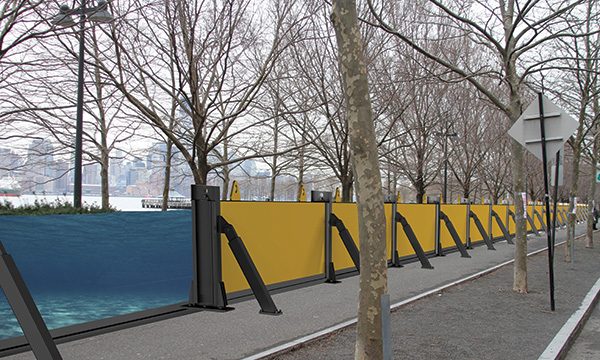
Can a solution to our coastline’s vulnerability be found in a 300-by-12-foot wave tank in Hoboken? At Stevens Institute of Technology, researchers at the Center for Maritime Systems are hoping to test the Removable Hurricane Flood Wall System, a new technology developed by RSA Protective Technologies of California. The system uses flood-control panels that are stored off-site until set in place when a threatening storm approaches.
Since Hurricane Sandy’s onslaught last October, the state has been awash in proposals for protecting threatened properties, from raising homes to replenishing beaches to building sea walls and dune systems. In urban areas like Hoboken, there is concern about Hudson River storm surges—not to mention antiquated storm drainage and sewer systems.
None of the solutions we’ve heard so much about is without controversy—and all come with considerable costs. But one thing is clear: New Jersey needs concrete and immediate solutions to protect vulnerable homes, businesses and tourist attractions. More storms are coming—and climate change studies suggest they will be stronger and more frequent.
That’s why I find RSA’s Removable Hurricane Flood Wall System so fascinating. The system—which is intended for urban areas, not beaches—has two parts. The first part is a permanent foundation, custom built to suit local soil conditions. The second part is a series of retractable steel posts that support steel-jacketed panels that can be installed prior to a flood. The panels are 6 to 7 inches thick and as much as 6 feet tall, depending on the area. “It is an invisible system until you need it and it won’t have an adverse environmental effect,” explains RSA president/founder Rick Adler.
Adler is working closely on the system with Dr. Alan Blumberg, director of the Davidson Laboratory/Center for Maritime Systems, as well as representatives from the federal office of Homeland Security and the offices of United States Senators Frank Lautenberg and Robert Menendez. Together they hope to create public-private partnerships to implement the flood-wall system in appropriate New Jersey locations.
“In essence, it is like putting up a dune,” says Blumberg, “but you are doing it in an urban environment like Hoboken, Weehawken or Jersey City, where there is no area to build a dune. This idea, to protect people and property from surges that are coming, is very creative. It’s not always there; it’s not permanent. If we have a future storm predicted, we can put up one mile in a 10-hour session. The forecasting technology gives you a good two to three days in advance, so that is ample time to prepare.”
In the wave tank at the Center for Maritime Systems, Blumberg’s team can replicate any type of storm surge and better understand the stresses the wall would sustain during a real storm. It’s thrilling to know that the research would be done right here in New Jersey—and in one of the very towns that might put the system to use.
Adler says the cost of the system is approximately $15 million a mile, which includes the assessment, installation and the product itself. Additional costs would be incurred whenever the system is erected.
Who would pay? “We have been told that FEMA will pay 75 percent to a town that is willing to sign up,” says Adler. “My company…has been talking with major financial institutions to see if they will come up with some program for public funding for the other 25 percent, so the towns don’t have to immediately pony up that money.”
Although there has been promising dialogue about the flood wall with the state Department of Environmental Protection, the federal EPA and FEMA, the success of such a system will ultimately rely on local governments working together. If only one town installs the system, flood waters will flow to neighboring towns. “It only works as a regional solution,” says Blumberg.
It’s time to put all the ideas on the table to protect New Jersey’s homes and businesses and our beautiful coastline. Time and climate change are clearly not on our side. It’s good to know that technology is.
